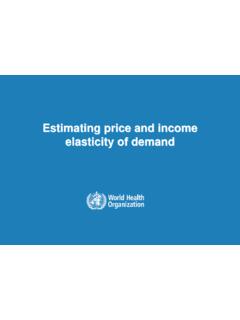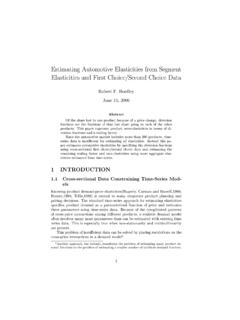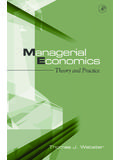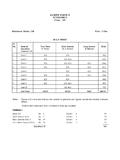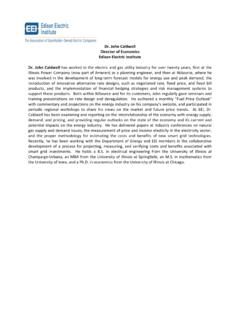Transcription of Chapter 3. Poverty Lines - World Bank
1 Poverty Manual, All, JH Revision of August 8, 2005 Page 42 of 218 Chapter 3. Poverty Lines Summary The poor are those whose expenditure (or income ) falls below a Poverty line . This Chapter explains how Poverty Lines are constructed and discusses the strengths and weaknesses of defining Poverty Lines based on three methods: the cost of basic needs, food energy intake, and subjective evaluations. The construction of a Poverty line is the most difficult step in the practical measurement of Poverty . Most commonly used is the cost of basic needs approach. It first estimates the cost of acquiring enough food for adequate nutrition usually 2,100 Calories per person per day and then adds on the cost of other essentials such as clothing and shelter.
2 When price information is lacking, one may use the food energy intake method, which graphs expenditure (or income ) per capita against food consumption (in Calories per person per day); from this one may determine the expenditure (or income ) level at which a household acquires enough food. Subjective Poverty Lines are based on asking people what minimum income level is needed in order to just make ends meet. An absolute Poverty line remains fixed over time adjusted only for inflation as in the United States. It allows one to track the evolution of Poverty over time, and is also useful when evaluating the effects of policies and programs on the incidence of Poverty . However, in most countries Poverty Lines are revised from time to time; these allow one to measure relative but not absolute Poverty , but typically reflect the evolution of social consensus about what constitutes Poverty .
3 The choice of Poverty line depends on the use to which it will be put: thus for international comparisons the $1/day standard is helpful, while for targeting the poor a relative Poverty line suffices. The appropriate choice of Poverty line is a matter of judgment, and will therefore vary from country to country. Learning Objectives After completing the module on Poverty Lines , you should be able to: 15. Explain what a Poverty line is, why it is needed, and how countries adjust their Poverty Lines over time. 16. Distinguish between absolute and relative Poverty Lines , and identify the conditions under which one might be preferred to the other. 17. Identify the steps required to construct a Poverty line using the Cost of Basic Needs method, and justify the choices made at each step.
4 18. Show how to construct a Poverty line using the Food Energy Intake method, and explain the serious weaknesses of this method. 19. Explain how subjective Poverty Lines are constructed and critically appraise their usefulness. 20. Construct a Poverty line using real survey data, using a. The Cost of Basic Needs method. b. The Food Energy Intake method. Note: This Chapter includes embedded questions, which you are encouraged to tackle as you read the text. Poverty Manual, All, JH Revision of August 8, 2005 Page 43 of 218 How to define a Poverty line Let us assume that we have chosen a measure of household well-being - say consumption expenditure. The next step is to choose a Poverty line . Households whose consumption expenditure falls below this line are considered to be poor.
5 Following common practice, the poor are defined as those who lack command over basic consumption needs, including food and non-food components. Thus, the Poverty line , thus, is obtained by specifying a consumption bundle considered adequate for basic consumption needs and then by estimating the cost of these basic needs. In other words, the Poverty line may be thought of as the minimum expenditure required by an individual to fulfill his or her basic food and non-food needs. Once we have computed a household s consumption, we need to determine whether that amount places the household in Poverty , or defines the household as poor . The threshold that we use for this is the Poverty line .
6 The Poverty line defines the level of consumption (or income ) needed for a household to escape Poverty . It is sometimes argued that the notion of a Poverty line implies a distinct turning point in the welfare function. That is, by rising from just below to just above the Poverty line , households (and individuals therein) move from considerable misery to an adequate minimum amount of well-being. However, given that well-being follows a continuum, and given how arbitrary the choice of Poverty line is, the notion of such a turning point is not very compelling. A corollary is that it may make sense to define more than one Poverty line . For example, one common approach is to define one Poverty line that marks households that are "poor," and another lower level that indicates those that are "extremely poor.
7 " Another approach is to construct a food Poverty line , which is based on some notion of minimum amount of money a household needs to purchase some basic-needs food bundle and nothing more. If the cost of basic non-food needs is estimated, then the food Poverty line added to the non-food needs will equal the overall Poverty line . Poverty Manual, All, JH Revision of August 8, 2005 Page 44 of 218 More formally, the Poverty line for a household, zi, may be defined as the minimum spending/consumption (or income , or other measure) needed to achieve at least the minimum utility level uz, given the level of prices (p) and the demographic characteristics of the household (x), so: ( ) ()Ziuxpez,,= In practice we cannot measure uz, or even e(.)
8 , and so a more pragmatic approach is needed. There are two approaches. One is to compute a Poverty line for each household, adjusting it from household to household to take into account differences in the prices they face and their demographic composition. For example, a small household in a rural area may face low housing costs and relatively modest food prices. Thus, their zi may be low compared to a large household living in a city where housing is more expensive and food prices are perhaps higher. This gives different Poverty Lines for each household. A second, and more widely used, approach is to construct one per capita Poverty line for all individuals, but to adjust per capita yi for differences in prices and household composition.
9 The adjusted per capita yi is then compared with the one Poverty line to determine if the individual is living below the Poverty line . With this approach, it is easier to talk of the Poverty line and present it as a single number. The approach taken for Cambodia in 1999 is somewhere between these two extremes. Separate Poverty Lines were constructed for each of three major regions , based on the prices prevailing in those areas; whether a household in any given region is poor is then determined by comparing its expenditure per capita with the appropriate regional Poverty line . These Poverty Lines are shown in table , based on Gibson s (1999) Poverty profile of Cambodia using the CSES 1999 data, and Prescott and Pradhan s (1997) profile using the SESC 1993/94 data.
10 We discuss the construction of these Poverty Lines in more detail below. 1. A Poverty line is: A The minimum expenditure required to fulfill basic needs. B The threshold consumption needed for a household to escape Poverty . C Somewhat arbitrary because the line between poor and non poor can be hard to define. D All of the above Poverty Manual, All, JH Revision of August 8, 2005 Page 45 of 218 Table : Summary of Cambodia Poverty Lines 1993/94 SESC 1999 CSES Food Poverty line Poverty line Food Poverty line Poverty line (riels per person per day) Phnom Penh 1185 1578 1737 2470 Other Urban 995 1264 1583 2093 Rural 881 1117 1379 1777 Source: Prescott and Pradhan (1997); Gibson (1999).










